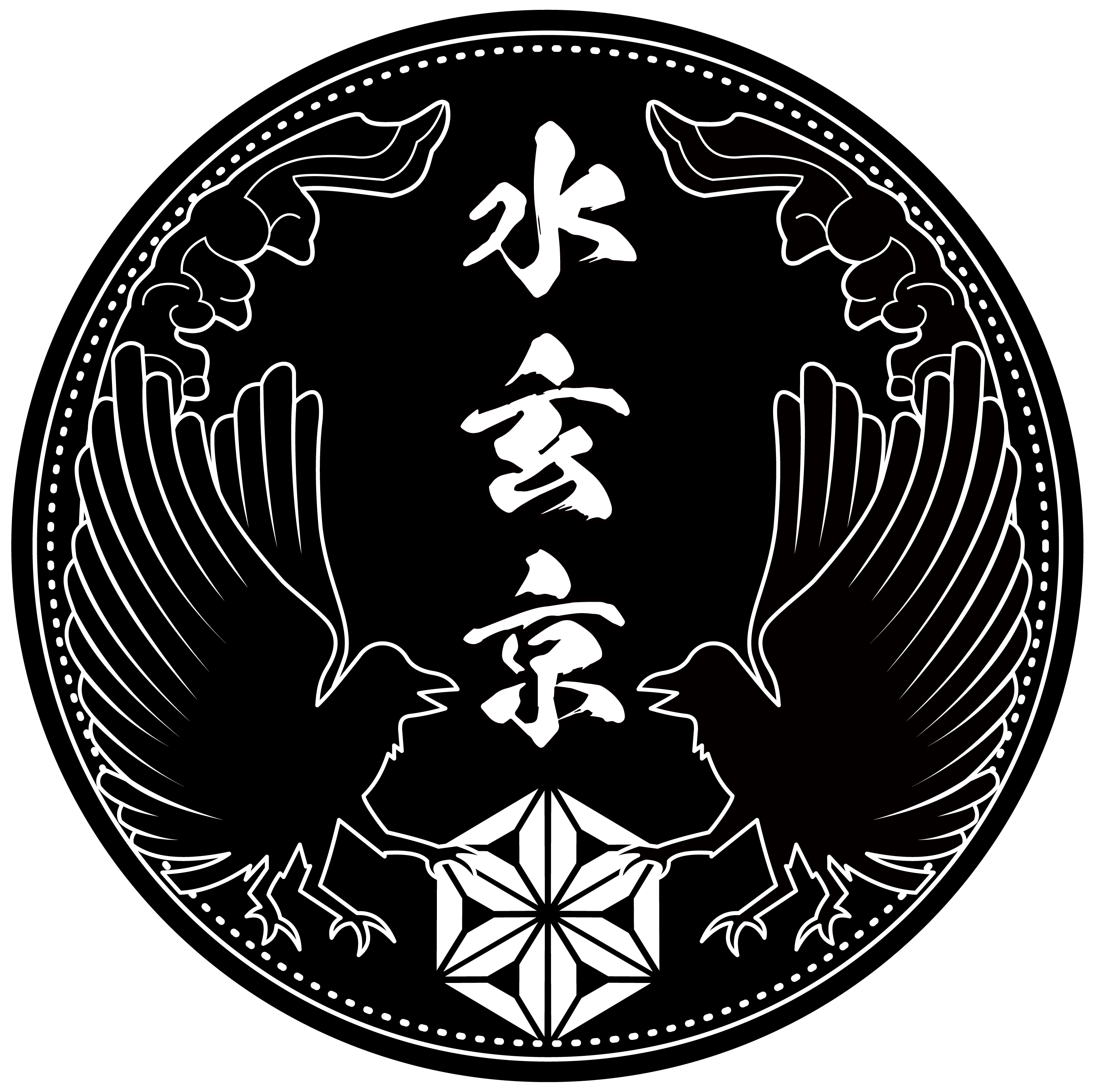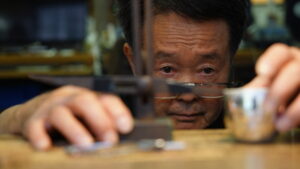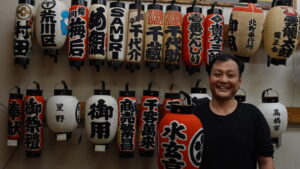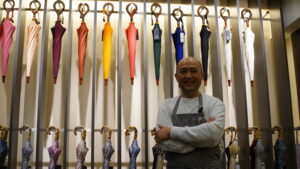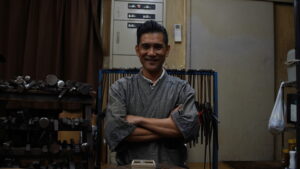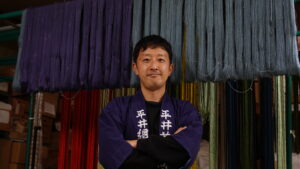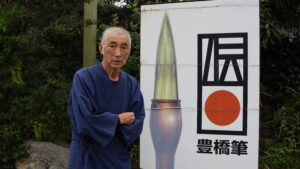Marumo Takagi Toki Co., Ltd. is located in Tajimi City, Gifu Prefecture, Japan. In addition to pottery, the company also handles a variety of other products, including glassware. The person we interviewed today is the fifth generation representative, Mr. Shoji Takagi. In order to convey the charm of Mino pottery, he travels around the world, both domestically and internationally, visiting many places in person. At first impression, I felt that he is a little different from the conventional image of a craftsman. We asked Mr. Takagi about his past and future plans.
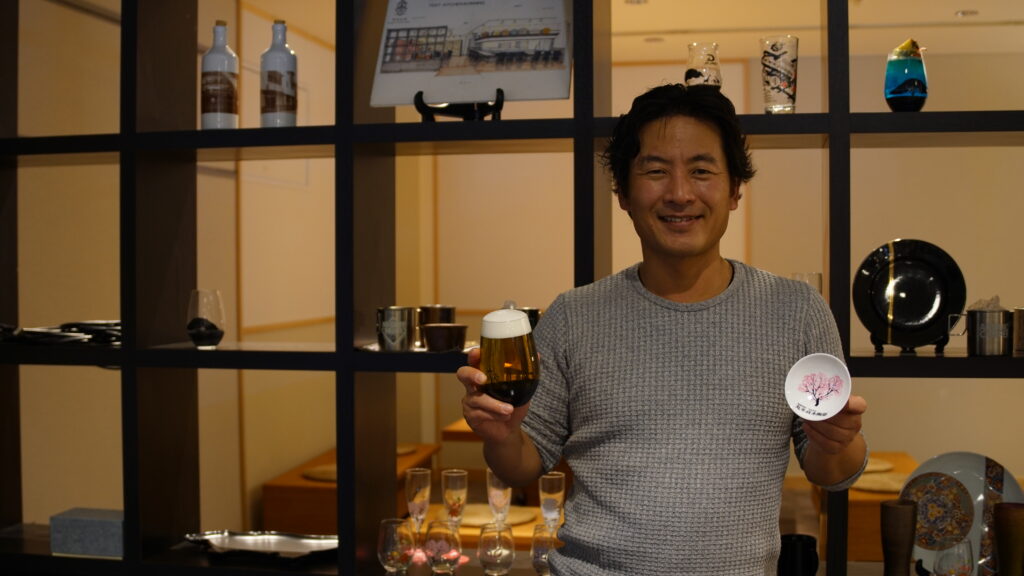
- ―What was your childhood like?
-
When I was little, I played a lot of sports. Soccer, baseball, and I was also in the Boy Scouts. It’s a pretty rural area, so I also did things like zip-lining in the mountains behind the school. I think I lived a pretty outdoorsy life from the perspective of people living in the city.
- ―What was your career path?
-
I went to an integrated boys’ school with a middle school, high school, and college. When I was a sophomore in high school, my mother suggested that I study abroad in Wisconsin, USA. I didn’t have a strong yearning to go abroad, but I trusted my parents and I was an honest child, so I thought going abroad was the right choice, and I took the plunge. I am the eldest of four siblings, and after I studied abroad, the other three siblings all went abroad as well (laugh).
After graduating from high school, I went straight to university to study business administration. I was aware that my parents were running a company, so I chose this department because I thought it would be better to study management.
- ―Did you go straight into the family business after graduation?
-
No, I did not go straight into the family business, but went to work for a western tableware manufacturer in Nagoya, where I worked for three years. Since the company was headquartered in Nagoya, I imagined I would stay in my hometown, but I was surprised when I was assigned to Hokkaido (laughs). I was surprised to find myself assigned to Hokkaido (laugh), but perhaps because I had been to the U.S., Hokkaido felt strangely close to me.
My job was to sell to clients such as hotels and restaurants. In other regions, I would have been assigned to a specific field, such as restaurants for restaurants only, but in Hokkaido, I was able to approach a wide range of clients, so it was a great experience for me to see the inside of various industries and business sectors.
- ―I’m surprised that you were assigned to Hokkaido–you worked there for 3 years before joining the family business.
-
I was backpacking in Thailand for a month before joining the family business. At the time, Saruwaishi was popular, and I was a wandering traveler who admired them (laughs).
After that trip was over, I joined the family business and started by being taught simple jobs such as packing and packing. Of course, I had worked for a western tableware manufacturer, so I had some understanding of pottery. During this period, I was concentrating on getting used to the work rather than working hard at something.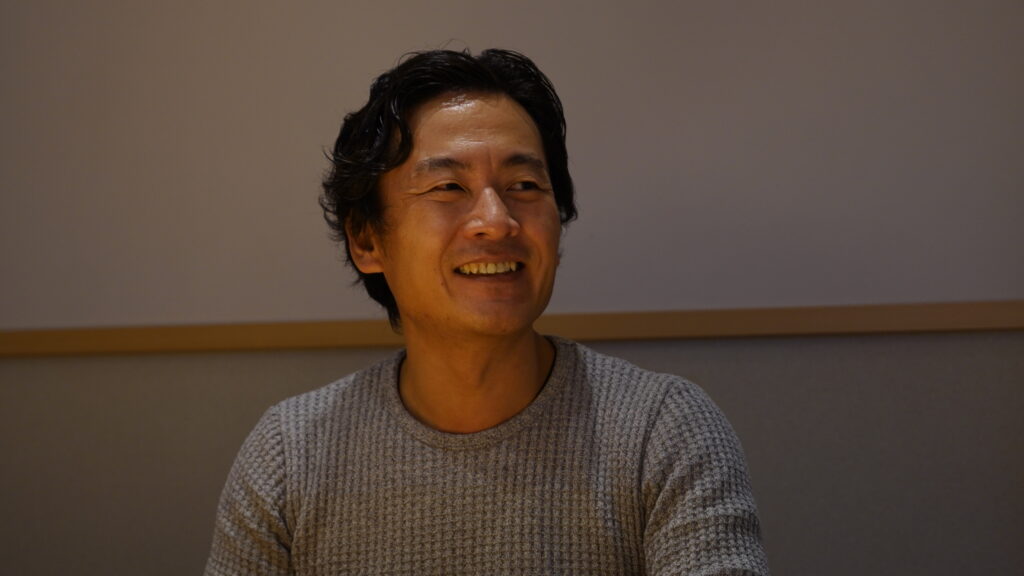
―What did you have in mind when you joined the family business?-
I was thinking about what I could do for the family business by comparing my experience in Hokkaido with my work in the family business. I didn’t even understand the structure of retail at the time I entered the workforce. I didn’t even know our competitors, and I was clueless.
In the way I knew nothing about it, the thing I felt the most was that “profit is in the source. Products reach the customer through many customs offices, including trading companies, wholesalers, and stockists. I did not realize this when I was in Hokkaido, but when I came back to the family business, I thought that if we could skillfully purchase products other than pottery, we could create a system that would benefit all three parties. When this idea came to me, I felt that I understood the commercial distribution system for the first time.
- ―What were you aware of when you took over the family business and became the representative?
-
I was trying to create a top-down structure as the leader of the company. I did not want to be a one-man operation, but rather I wanted to create a command post that would give me direction based on my understanding of the situation around me. This is just my personal opinion, but I think that many people at the top these days don’t want to take on responsibility. I don’t think that should be the case at the top, and I think it is necessary for top management to experience many things firsthand and pass them on to their subordinates. For example, the reason why I visit hotels and restaurants so often is so that my subordinates can express their opinions based on their own experiences, such as, “This type of tableware goes well with this type of place. I believe that there are many things that cannot be understood without actually going there, and this is especially true for overseas business trips. It is only after experiencing the culture of a foreign country that one can look at Japan objectively. From there, I sometimes ask many employees, including female employees, for their opinions as a second opinion, and then finalize a strategy.
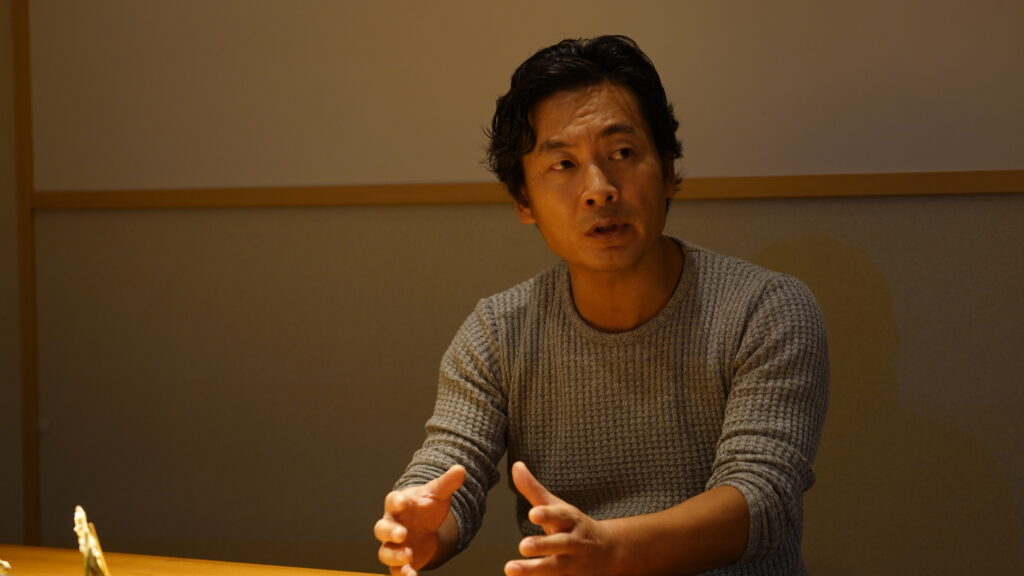
- ―I was wondering if there is anything that you are conscious of as a craftsman?
-
First of all, I like to create and think, and I like to devote myself to production and marketing. However, I believe that the era of simply creating things is over, and I think it is very important to decide whether to focus on “product out “1 or “market in “2. I believe that no matter how high the quality of a product in this day and age, if it is not recognized, it will not sell or even be distributed. I thought that products would not be effective unless I grasped the entry and exit points, and came up with the idea of “Cold Cherry Blossom,” which is also our signature product. I believe that this product is a product that opens both the entrance and exit doors I mentioned earlier all at once. I believe that the key to this door was the mass media and social networking sites.
1) Product Out: Product development based on what the creator wants to make and what can be made.
2)Market-in: Product development based on the opinions and needs of customers, as opposed to product-out. - ―What exactly was the process of gaining recognition?
-
The basic premise was that I myself had an ambition to have Japanese embassies all over the world toast with sake in “Cold Cherry Blossom”. However, it turned out to be a Corona and it did not work out as I had hoped. However, the mass media changed the expression to something like “a magic sake cup for enjoying Hanami at home,” and we succeeded in changing direction, albeit gradually. Originally, this product was targeted at overseas customers and not at Japanese people. However, we assumed that the entrance was the product and the exit was the market, and when we opened both doors, we created a strong gust of wind and The wind was the mass media and social networking sites. That wind was the mass media and SNS. As a result, I am glad that we were able to settle down in a place that matched the world’s demand. Of course, we are looking forward to approaching overseas markets in the future.
- ―-That’s interesting! I think that conventional craftsmen are strongly conscious of “preserving tradition,” while you are strongly conscious of “cutting-edge technology and flexible ideas. I wonder if you are a relative of the conventional image of a craftsman.
-
Of course, I am always thinking about preserving and preserving tradition. This town has always been famous for its sake cups, and we have been making a lot of moves to upgrade them. In my opinion, innovation is “being able to make customers want something they don’t think they need to buy. In the course of product development, we take on new challenges, such as the thickness, size, design, and color of the sake cups. Then we go back to the basics and try to use past products as references. I believe that creating something new by going back and forth is what evolution is all about. Therefore, I do not deny the path of pursuing “staying the same” all the time, and I think it is a good one. With this “never change” in mind, I continue to think and come up with ideas about where the exit for traditional crafts should be.
- ―What is the source of your ideas, Mr. Takagi?
-
It’s about looking everywhere in our daily lives. Above all, I enjoy thinking about new products. (laugh) For example, one day when I went to the washbasin, I looked at the water coming out of the faucet and thought it was a waste. There is a little bit of cold water coming out before the warm water comes out. When I saw that people were doing different things with the water until it became warm, I wondered if there was something I could do about it. I thought that if there was a product that changed color when the cold water changed to warm water, it would be a good contribution to society. We came up with the idea of creating a product that would allow people to see the change in water temperature without having to touch it, and that would also convey the message of protecting water as a resource. I gave it to my employees and said, “Try it at home! and they said, “Boss! The kids are so happy to see it! I thought it would be a good incentive for children to go to the washroom voluntarily. This was the first time for me to make something other than a food container.
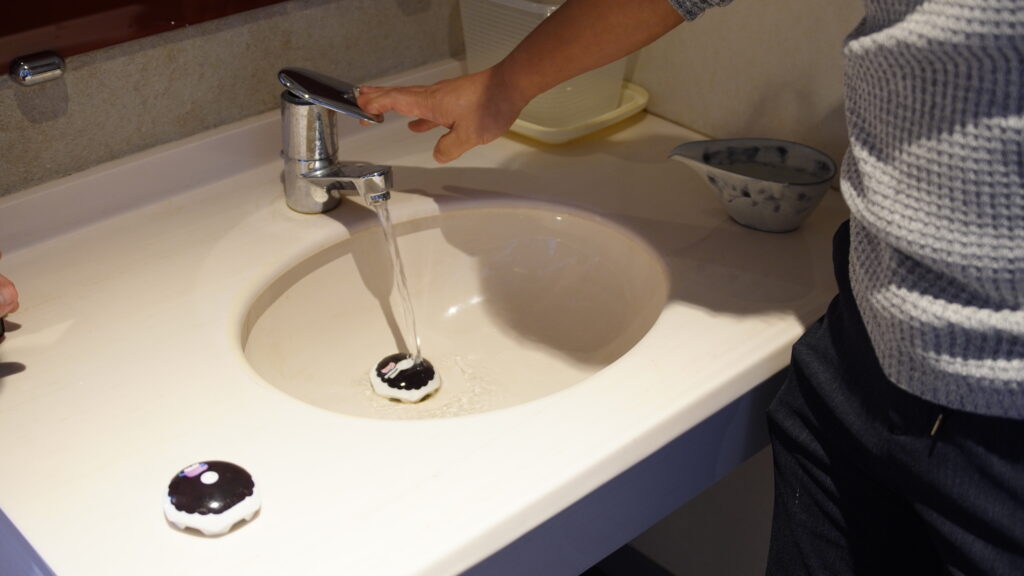
- ―Lastly, what are your future plans?
-
I would like to produce things in the world that are desired by people overseas, although Japanese people tend to underestimate the importance of them.
For example, if you go to France for the first time, wouldn’t you buy a key chain with the Eiffel Tower on it? It is natural, but I don’t think French people would buy it. In the same way, if you stay in Japan for a long time, you get used to the same input, so you tend to think that sticky designs are not good enough. However, designs of ninja, samurai, cherry blossoms, Mt. Fuji, and kabuki are fresh to foreigners. That’s why we thought “Cold Cherry Blossom” would be popular overseas. From there, we began to select shapes and colors that would meet the demand in each country and worked hard to develop products.
I believe that using cross-border EC to sell such products is essential to our future prospects. In the future, we intend to actively visit foreign countries to deepen our knowledge and exchange, and establish a system that will enable us to meet overseas demand! We would like to become a company that can provide all-Japan products and compete on the world stage.
After the interview
Listening to Mr. Takagi’s talk made me think about “what is a craftsman” and “what is tradition? In a world where the phrase “tradition is protected” is often used, I thought that it could be said that “protecting” alone does not allow for significant development or evolution. I felt that the attitude of developing products that meet the needs of the modern age, while also being on the “offensive,” or “improving,” rather than just “defending,” may be the ideal attitude for craftspeople in the future. What should not change. What should not change and what must change. This interview made me strongly believe that it is necessary to pursue this proposition in all things, regardless of crafts.
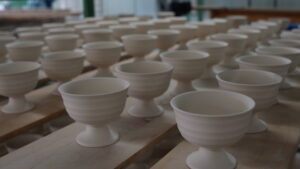
Suigenkyo Online Store
We offer a wide range of products including tableware, accessories, and interior design.
Suigenkyo YouTube
You can see the making process of the products listed on Suigenkyo Online Store.
